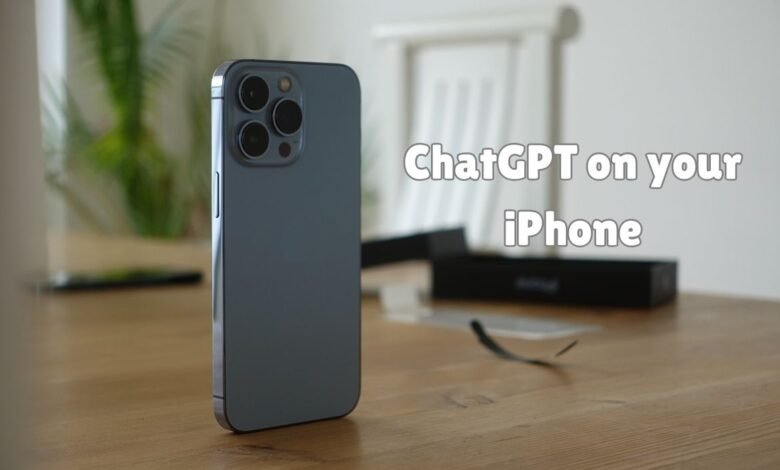ChatGPT on your iPhone? The four reasons why this is happening far too early
ChatGPT on your iPhone? Discover four reasons why this rollout might be happening too early, impacting user experience and functionality.

ChatGPT, an advanced AI language model developed by OpenAI, has recently made its way to iPhones, generating considerable excitement among technology enthusiasts and everyday users alike. The notion of having such a powerful AI tool readily accessible on a mobile device opens up a world of possibilities. Imagine having an intelligent assistant capable of understanding and generating human-like text, aiding with tasks ranging from drafting emails to providing instant answers to complex questions, all at your fingertips. The potential benefits are immense, offering convenience, efficiency, and a touch of futuristic innovation in our daily lives.
However, as thrilling as this development may be, it’s essential to take a step back and consider whether the integration of ChatGPT on iPhones might be a bit premature. This blog aims to delve into the reasons behind this concern, providing a balanced exploration of the current state of this technology. While the advantages are clear, there are underlying challenges and limitations that could impact user experience and the broader implications of deploying such AI on a widely-used platform like the iPhone.
The discussion will encompass various aspects, including the technical readiness of ChatGPT for mobile use, potential privacy and security issues, user dependency risks, and the ethical considerations of integrating AI into everyday life. By examining these factors, we aim to provide a comprehensive understanding of why the excitement around ChatGPT on iPhones might need to be tempered with cautious optimism.
Join us as we navigate through the intricacies of this technological advancement, weighing its immediate allure against the potential hurdles that suggest it might have arrived just a bit too soon.
Reason 1: Technical Limitations
The integration of advanced AI models like ChatGPT into mobile devices such as the iPhone presents several technical challenges. These hurdles stem primarily from limitations in processing power, battery life, and storage capacity. Below, we delve into these challenges in detail, providing a balanced perspective on the pros and cons of this technological endeavor.
- Processing Power: The intricate computations required by ChatGPT demand substantial processing power. While iPhones are equipped with sophisticated processors, such as the A-series chips, they are still not on par with the high-performance GPUs and TPUs typically used in data centers to run these AI models. This disparity can result in slower response times and a less seamless user experience.
- Battery Life: Running a resource-intensive AI like ChatGPT can significantly drain an iPhone’s battery. Given that mobile users prioritize battery longevity, the continuous operation of such AI could lead to frequent recharges, thereby diminishing the device’s portability and convenience.
- Storage Limitations: ChatGPT models require substantial storage space for their extensive datasets and processing algorithms. Although iPhones offer considerable storage options, integrating a full-scale AI model could consume a significant portion of available space, leaving less room for other applications and personal data.
Technical Specifications Comparison
| Specification | ChatGPT Requirements | iPhone Capabilities |
|---|---|---|
| Processing Power | High-performance GPUs/TPUs | A-series chips (e.g., A14, A15) |
| Battery Life | Continuous power supply | Limited to battery capacity (e.g., 3000mAh) |
| Storage Space | Several GBs for datasets | 64GB to 512GB (user-dependent) |
Despite these limitations, there are notable advantages to incorporating AI models like ChatGPT into iPhones. Enhanced user interaction, personalized assistance, and the ability to perform complex tasks on-the-go are significant benefits. However, these pros must be weighed against the technical constraints to determine the feasibility and practicality of such integration.
Reason 2: User Experience Concerns
The user experience plays a pivotal role in the success or failure of any application, and the early release of ChatGPT on iPhones brings several challenges in this regard. The integration of an advanced AI like ChatGPT on a small-screen device such as the iPhone can be problematic, leading to a suboptimal user experience. Below are some key concerns:
- Lag and Performance Issues: Users may experience lag, which can hinder real-time interactions. This is especially problematic for an application like ChatGPT that relies on quick responses.
- Frequent Crashes: Early versions of the app may be prone to crashes, disrupting the user experience and causing frustration.
- Screen Size Limitations: The complexity of using an advanced AI on a small screen can make navigation and interaction cumbersome. Essential features may be difficult to access or utilize effectively.
User feedback has already highlighted some of these issues. One early adopter noted, “While ChatGPT’s capabilities are impressive, the app frequently crashes, and the lag makes it hard to have a smooth conversation.” Another user mentioned, “Navigating through the options on a small screen is quite challenging. It feels like the app is not optimized for mobile use yet.”
Pros and Cons of Using ChatGPT on an iPhone
| Pros | Cons |
|---|---|
| Portable access to advanced AI | Lag and performance issues |
| Convenient for quick queries | Frequent crashes |
| Potential for future updates and improvements | Complexity of use on small screens |
| Useful for on-the-go assistance | Limited feature accessibility |
In summary, while ChatGPT on iPhones offers the convenience of accessing advanced AI on-the-go, the current state of the app is marred by performance issues, frequent crashes, and the inherent limitations of small-screen navigation. These factors significantly impact the user experience, highlighting the need for further optimization before it can meet user expectations effectively.
Reason 3: Privacy and Security Issues
One of the primary concerns about using ChatGPT on iPhones is the potential for privacy and security issues. Mobile devices are inherently more vulnerable to data breaches and unauthorized access compared to desktop environments. This vulnerability raises significant worries about how user data might be used or stored when interacting with ChatGPT on an iPhone.
Key privacy and security concerns include:
- Data breaches: Mobile devices are frequent targets of cyber-attacks. If ChatGPT’s servers were compromised, it could expose sensitive user data.
- Unauthorized access: There is a risk that unauthorized parties could access conversations, especially if the device itself is not adequately secured.
- Data usage and storage: Users may be concerned about how their data is used, stored, and shared by OpenAI and third parties.
To provide a clearer picture, consider the following comparison of security features between ChatGPT and standard iPhone security measures:
| Feature | ChatGPT | iPhone Security |
|---|---|---|
| End-to-End Encryption | Not Always Guaranteed | Standard for iMessages and FaceTime |
| Data Storage | Stored on Servers | Encrypted and Stored Locally |
| Access Control | Server-Side Authentication | Biometric and Passcode Protection |
For users who choose to use ChatGPT on their iPhones, there are several steps they can take to enhance their data protection:
- Enable biometric authentication (Face ID or Touch ID) to prevent unauthorized access to the device.
- Regularly update both the ChatGPT app and iPhone software to ensure the latest security patches are applied.
- Use a virtual private network (VPN) to encrypt internet traffic and protect against network-based attacks.
- Carefully review app permissions and disable any that seem unnecessary or intrusive.
By being proactive about privacy and security, users can mitigate some of the risks associated with using ChatGPT on their mobile devices.
Reason 4: Market Readiness and Adoption
When considering the integration of ChatGPT into iPhones, an essential factor is market readiness and user adoption. The adoption rate of similar AI technologies provides valuable insights into how prepared users are for such a significant shift in their daily interactions with mobile devices. While AI has steadily made its way into various aspects of our lives, several factors influence market readiness for a full-scale integration of ChatGPT on iPhones:
- User Familiarity with AI: Many users are already accustomed to basic AI functionalities, such as virtual assistants like Siri and Google Assistant. However, the intricate and advanced capabilities of ChatGPT may require a more considerable learning curve.
- Cost of Implementation: Implementing advanced AI technologies can be costly. From research and development to integration and maintenance, these expenses can deter both developers and consumers, especially if the perceived value does not justify the cost.
- Competition from Other Apps: The market is saturated with various AI-driven apps, each vying for user attention. ChatGPT must offer unique and compelling features to stand out amidst fierce competition.
To better understand the market readiness, a pros and cons table is helpful:
| Pros | Cons |
|---|---|
| High user interest in AI and innovative technologies | Steep learning curve for advanced AI functionalities |
| Potential to enhance productivity and user experience | High implementation and maintenance costs |
| Growing acceptance of AI in daily life | Significant competition from established AI apps |
- Windows Subsystem for Linux (WSL): How to Run a Linux Desktop Using it
- Samsung Galaxy S24 FE with Exynos 2400 surfaces in benchmarks
- Samsung Galaxy M55 5G: Mid-range powerhouse
Looking forward, for ChatGPT to be seamlessly integrated into mobile devices, several steps are crucial. Enhanced user education on the benefits and functionalities of ChatGPT can mitigate the learning curve. Cost-effective implementation strategies must be developed to make the technology accessible to a broader audience. Additionally, continuous innovation and differentiation will be key in maintaining a competitive edge in the market. By addressing these factors, the transition to widespread adoption of ChatGPT on iPhones can become a more feasible reality.



